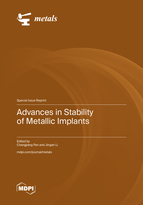Advances in Stability of Metallic Implants
A special issue of Metals (ISSN 2075-4701). This special issue belongs to the section "Biobased and Biodegradable Metals".
Deadline for manuscript submissions: closed (30 June 2023) | Viewed by 18234
Special Issue Editors
Interests: biomaterials; nanomaterials; medical devices; tissue engineering; drug delivery
Interests: biofabrication; biomodification; micropatterning; tissue regeneration; biodegradable metal
Special Issues, Collections and Topics in MDPI journals
Special Issue Information
Dear Colleagues,
Metallic implants play an important role in promoting human health and disease treatment. Tissue and organ defects or functional damage caused by trauma and disease pose a great demand and challenge for metallic implants. The stability of metallic implants plays an important role in the clinical performance of medical implants, and have attracted more and more attention from researchers in the last few decades. Significant advances in this field have a close relationship with medicine, biomaterials, numerical simulation, biomaterials preparation and characterization, surface biofunctionalization of the metallic implants, etc.
The aim of this Special Issue, “Advance in Stability of Metallic Implants”, is to publish research articles in full length, short communications, and review articles covering the latest studies, progress, and challenges on the design, preparation, characterization, and evaluation of metallic implant and their biomaterials for their future application in clinical settings.
Topics addressed in this Special Issue may include, but are not limited to:
- Computational modelling and numerical simulation of metallic implants;
- Biofunctionalization of biomaterials to enhance the stability of metallic implants;
- Metallic design and characterization for medical devices;
- Surface modification of biomaterials and metallic implants;
- The interactions between metallic implants and tissue;
- New fabrication techniques and characterization of the metallic implants;
- Investigation methods/modeling for metallic implants development;
- Design, preparation, and characterization of new metallic implants.
Prof. Dr. Changjiang Pan
Prof. Dr. Jingan Li
Guest Editors
Manuscript Submission Information
Manuscripts should be submitted online at www.mdpi.com by registering and logging in to this website. Once you are registered, click here to go to the submission form. Manuscripts can be submitted until the deadline. All submissions that pass pre-check are peer-reviewed. Accepted papers will be published continuously in the journal (as soon as accepted) and will be listed together on the special issue website. Research articles, review articles as well as short communications are invited. For planned papers, a title and short abstract (about 100 words) can be sent to the Editorial Office for announcement on this website.
Submitted manuscripts should not have been published previously, nor be under consideration for publication elsewhere (except conference proceedings papers). All manuscripts are thoroughly refereed through a single-blind peer-review process. A guide for authors and other relevant information for submission of manuscripts is available on the Instructions for Authors page. Metals is an international peer-reviewed open access monthly journal published by MDPI.
Please visit the Instructions for Authors page before submitting a manuscript. The Article Processing Charge (APC) for publication in this open access journal is 2600 CHF (Swiss Francs). Submitted papers should be well formatted and use good English. Authors may use MDPI's English editing service prior to publication or during author revisions.
Keywords
- metal
- biomaterials
- implants
- surface modification
- biofunctionalization
- biocompatibility
- materials characterization
- biomedical devices






